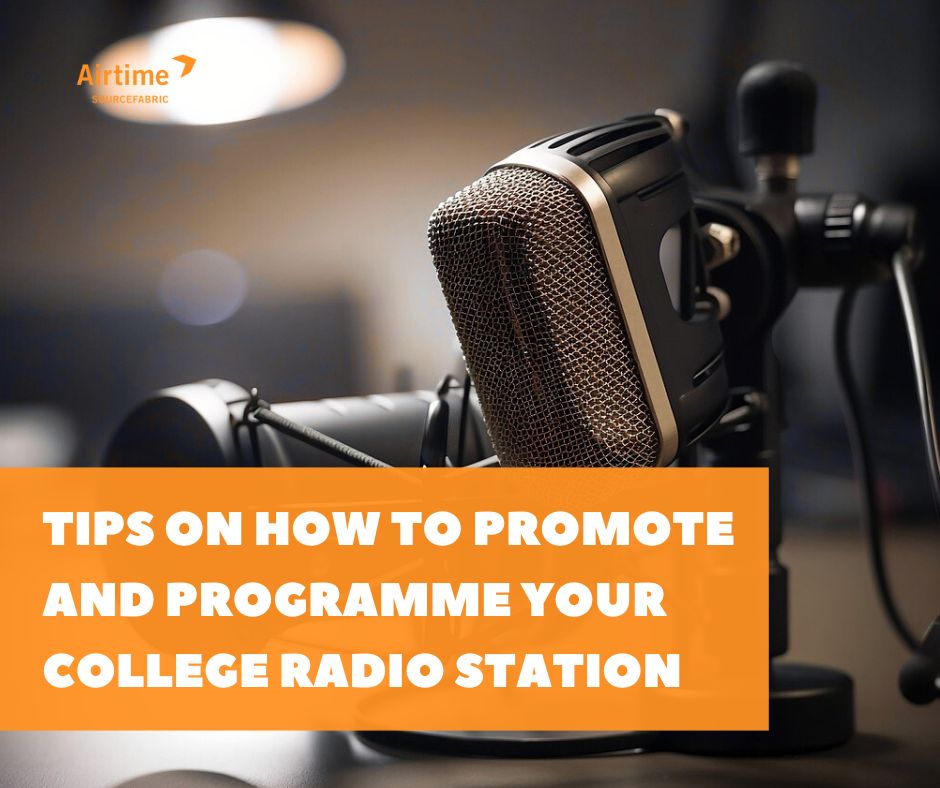For many students, working at a college radio station is one of the most exciting parts of university life. But for a university station to thrive, it needs two things: strong promotion and great programming.
Here at Airtime Pro, we’re strong believers in the power of radio to build community. We’ve already published a guide on how to launch a college radio station, from defining your station’s identity to building a team and launching your first broadcast.
Once you’ve got the basics in place, the next challenge is making sure people listen and keep tuning in.
We’ve collected top tips from some of the hottest student radio stations out there to help you find – and keep – your own online radio groove.
Promoting Your Station
1. Build a Social Media Presence
Today, students often look for information on social media before going to a website, so it’s important to be present on all major platforms.
Create accounts on Instagram, TikTok and X (Twitter). Post short clips of live shows, behind-the-scenes moments, playlists, and polls. Instagram Reels and TikTok videos are especially effective for giving listeners an inside look at your station.
The University of California, Berkeley’s student and community radio station, KALX Berkeley 90.7 FM, has more than 11,300 followers on Instagram, where they share weekly programmes, photos with interviewees, and reels about daily life at the station.
Alongside social media, it’s essential to maintain a website. With Airtime Pro, you can embed a widget that makes it easy for students to listen with a single click.
2. Collaborate with Societies and Events
Work with student societies, sports teams, and clubs. You can cover their events, conduct interviews with their members, or broadcast live from campus gigs and matches.
Also, take part in College Radio Day, an annual worldwide event where hundreds of student radio stations come together to celebrate the unique role of college radio. It’s a great opportunity to raise your profile, share content internationally, and highlight the importance of student broadcasting.
3. Increase Visibility on Campus
Put up posters and flyers in places where students gather, such as cafés, libraries and offices of other student organisations. Ask your school’s administrators to add a link on the website about the radio station to make it easy for current, past and prospective students to find information and listen online.
4. Merchandise and Giveaways
Stickers, badges, and tote bags with the station logo are affordable and fun ways to spread awareness of your online radio station. Competitions where students can win tickets to music shows or get discounts to events also encourage engagement.
CKUT-FM, a non-profit campus and community radio station based at McGill University in Montreal, Canada, has created its own range of merchandise, including T-shirts, hoodies, and tote bags.
Use Airtime Pro’s analytics feature to identify your most popular shows and link your giveaways to them.
5. Host Live Events
Live events give people a reason to interact with the station in person. Think themed club nights, open-mic evenings, or live broadcasts from the cafeteria.
If anyone misses your event, schedule replays on your station with Airtime Pro so listeners can catch up later.
Your Programming
Of course, once you’ve attracted listeners, your content must hold their attention. A strong schedule should balance music, talk segments, entertainment, and student-focused information.
Interviews
Bring on student leaders, academics, or local musicians for interviews. This makes your programming feel relevant and connected to campus life.
Make interviews engaging and fun. For example, a student at Sound Bricks Radio in Prague interviewed people while rock climbing – an unusual idea that made the show stand out.
Podcasts
Not everyone can tune in live, so upload recorded shows as podcasts with Airtime Pro. Students can then listen whenever they like. Podcasting is also a popular way to expand your reach.
CFUV-FM, Victoria’s only non-profit campus and community radio station in British Columbia, Canada, uses Airtime Pro to manage its content. The station hosts a variety of podcast shows covering everything from hot topics in the automotive world to gender and international human rights to the struggles of contemporary Indigenous peoples.
Music Programming
Strike a balance between popular hits and emerging artists, especially unsigned or student bands from your local area.
Theme nights also work well: “Throwback Thursdays” for nostalgia, “International Hits” for global sounds, or late-night electronica for niche listeners.
Special Segments
Keep things dynamic with more than just music and interviews. Add campus news, daily student updates, and monthly features on different societies or clubs. You could also run debates or panel discussions about student life.
Final Thoughts
A student radio station succeeds when it feels energetic and connected to its audience. By promoting it through social media, partnerships, and live events, and by filling the schedule with varied, student-centred programming, you can create something that people genuinely want to listen to and support.
The goal isn’t to be perfect or to sound like a commercial station. Instead, it’s to reflect the voice of your campus. Once students feel it represents them, your station will naturally become popular.
We’ve put together some handy resources to make it easier to start and programme your college radio station.
Enter your email below and click Submit to instantly download your free resources.


Leave a Reply